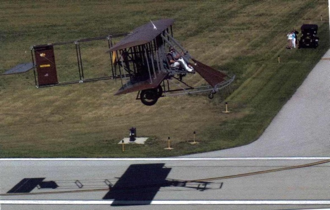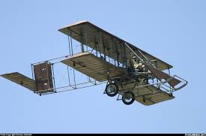MAYDAY in a Wright “B” Flyer
Peet Odgers
In the spring of 2003 I was asked to join the Wright “B” Flyer organization and help manage the abundant requests for aircraft appearances resulting from the 100th year anniversary of the Wright Brothers first powered flight. In the mid-70’s a group of Dayton, Ohio aviation enthusiasts built a Wright ”B” Flyer look alike to honor the Wright’s accomplishments. The original “B” was the first production aircraft bought by the US Army.

The photo shows the Wright “B” with Peet at the controls
Working for the organization also included flying the aircraft – a daunting challenge. As a career Air Force officer and pilot, I had accumulated 8,500 hours, mostly flying high performance jets. Following retirement, I became a partner in the ownership of a Bonanza. I felt I was certainly qualified to check out in the Wright “B”, but was soon to be surprised. The aircraft was a dog in the air. Flight instruments include an altimeter, airspeed indicator (mph) and a whiskey (magnetic) compass—that’s it! You gain experience in the Wright “B” by take-offs and landings, not total flying time. I had a terrible time mastering the coordination needed to blend roll, pitch, yaw and power when the aircraft was fighting every input. Further, there is no windscreen, so attempting to read a chart in flight for navigation purposes is close to impossible. For you aviators, the ”B”, which I affectionately called the “Beast” rotated (took off) at 40 mph (not knots), and cruised at 50 mph, usually at 1,000-1,500 feet above the ground, and with full throttle. Notice the comment, “full throttle”. The aircraft developed very high drag counts with increased speed—50-55 mph was the maximum speed while climbing to 1,000 feet above ground level (AGL), and took 20-30 minutes! This was quite a contrast from jets.
In August 2003, the Wright “B” was scheduled to perform a fly-by at a softball game between the Dayton Police and Fire Fighters. The ball field was in the center of downtown Dayton. The flight was scheduled for John Warlick, Chief Wright “B” pilot and an ex USN WWII carrier pilot, as pilot and myself as co-pilot. Similar to any cross-country flight, navigating at low level requires the selection of prominent land marks which, in this case were the bends in the Great Miami River. We successfully completed the fly-by at 300-400 feet, and after a prolonged climb-out headed home at 1,000 feet AGL. I was flying the aircraft and communicating with Dayton Approach Control as we overflew Dayton.
Passing over Moraine Air Park (Southwest of Dayton), the aircraft abruptly developed a high yaw rate, resulting in the aircraft flying sideways. John immediately took control and reduced power to idle. It was apparent that we had lost the power on one of the two bicycle chain driven props, thus the high yaw rate. The only way to control the aircraft was to eliminate the power. We were now a glider with a glide ratio similar to a simonized rock! John told me to declare an emergency.
We were now rapidly descending well below 1,000 feet headed for a crash landing in either the Great Miami River, or the more remote Moraine Air Park. I declared: “MAYDAY, MAYDAY, MAYDAY; Wright “B” Flyer attempting an emergency landing in the vicinity of Moraine Air Park!” John, the masterful chief pilot, was just able to convert a few mph of airspeed into a short glide, thus making the Air Park field boundary with an impact so severe I thought the landing gear would collapse the lower wing. We skidded across the field, taking out two taxiway lights and making a deep furrow, and finally came to rest a foot short of a hangar. John and I were both in shock, but survived without injury. Needless to say, I had to change my skivvies. Upon evacuating “Beast”, we found the left prop missing its bicycle chain which failed in flight. God knows who claimed that trophy. Surprisingly, a new bicycle chain fixed the problem—and off we went into the “Wild Blue” to our home plate.
I flew the Wright “B” for four more years with no similar encounters, but when flying cross-country, I always wore a Mae West survival vest in the event we had to crash land in a river.
More Wright "B" Flyer photos


